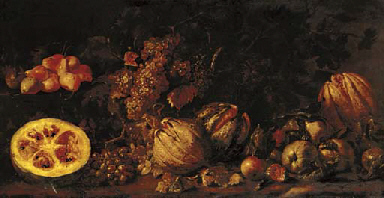Christ Driving the Money Changers from the Temple, oil on canvas, 124 x 174 cm, framed Provenance: Compagnoni Marefoschi collection, Macerata; their sale, Christie’s, Rome, 21 November 1995, lot 254 (as Viviano Codazzi ; where acquired by the present owner The present composition relates to the oeuvre of Viviano (circa 1604-1670) and Niccolò Codazzi (1642-1693) and it is especially close to the inventions of Viviano, who was born in Bergamo, but was active in Rome from the end of the 1640s and specialised in architectural compositions. Details that appear in this painting, such as the ionic capitals with grotesque masks, derived from those of the Palazzi Capitolini, Rome by Michelangelo, and are typical of the painter’s work of the 1660s. The principal episode of the scene takes place on the stairs of the main building characterised by a large central entrance arch, flanked by fluted ionic columns, surmounted by a large triangular pediment. This architectural typology compares with that represented in the Cortile di Palazzo by Viviano Codazzi conserved in the Galleria Nazionale di Palazzo Barberini (inv. no. 2407). The temple on the right, which is presumably tetrastyle, is comparable to that in a painting by Viviano conserved in the Gallery of the Castle in Prague (see D. R. Marshall Viviano and Niccolò Codazzi and the Baroque Architectural Fantasy, Rome 1993, cat. no. VC110). Elements from other compositions can be identified in the many figures animating the scene. For example, the figure of the seated woman on the right appears to have been taken from Guido Reni’s fresco, the Crucifixion of St. Andrew in the Oratory of Saint Andrew, Rome. The colour of the woman’s dress corresponds to Reni’s fresco, as does the blue worn by the boy: the implication is that the painter, who was borrowing from well-known works, was not just using an engraving but probably knew the original painting. The Palazzo Compagnoni Marefoschi in Macerata, where this painting once belonged, was enlarged from 1755 by Cardinal Mario (1714-1780) and his brothers Camillo and Giuseppe. Cardinal Mario Marefoschi was the secretary of the congregation of Propaganda Fide in 1759 and he is also known for the excavations he conducted at Hadrian’s Villa, Tivoli. The family palace was adorned with paintings, as well as marble statues and inscriptions taken directly from Hadrian’s Villa; it was also decorated with frescoes designed by Giovanni Stern Little is known of the collection of paintings since the only inventory known is that of Cardinal Prospero who died in 1732. During the latter’s residence in Rome the cardinal resided opposite Palazzo Venezia where his collection was housed, this was primarily composed of religious subjects by mid-seventeenth century Roman artists, but also included a number of sixteenth century paintings by masters such as Perin del Vaga, Francesco Salviati and Garofalo.
Christ Driving the Money Changers from the Temple, oil on canvas, 124 x 174 cm, framed Provenance: Compagnoni Marefoschi collection, Macerata; their sale, Christie’s, Rome, 21 November 1995, lot 254 (as Viviano Codazzi ; where acquired by the present owner The present composition relates to the oeuvre of Viviano (circa 1604-1670) and Niccolò Codazzi (1642-1693) and it is especially close to the inventions of Viviano, who was born in Bergamo, but was active in Rome from the end of the 1640s and specialised in architectural compositions. Details that appear in this painting, such as the ionic capitals with grotesque masks, derived from those of the Palazzi Capitolini, Rome by Michelangelo, and are typical of the painter’s work of the 1660s. The principal episode of the scene takes place on the stairs of the main building characterised by a large central entrance arch, flanked by fluted ionic columns, surmounted by a large triangular pediment. This architectural typology compares with that represented in the Cortile di Palazzo by Viviano Codazzi conserved in the Galleria Nazionale di Palazzo Barberini (inv. no. 2407). The temple on the right, which is presumably tetrastyle, is comparable to that in a painting by Viviano conserved in the Gallery of the Castle in Prague (see D. R. Marshall Viviano and Niccolò Codazzi and the Baroque Architectural Fantasy, Rome 1993, cat. no. VC110). Elements from other compositions can be identified in the many figures animating the scene. For example, the figure of the seated woman on the right appears to have been taken from Guido Reni’s fresco, the Crucifixion of St. Andrew in the Oratory of Saint Andrew, Rome. The colour of the woman’s dress corresponds to Reni’s fresco, as does the blue worn by the boy: the implication is that the painter, who was borrowing from well-known works, was not just using an engraving but probably knew the original painting. The Palazzo Compagnoni Marefoschi in Macerata, where this painting once belonged, was enlarged from 1755 by Cardinal Mario (1714-1780) and his brothers Camillo and Giuseppe. Cardinal Mario Marefoschi was the secretary of the congregation of Propaganda Fide in 1759 and he is also known for the excavations he conducted at Hadrian’s Villa, Tivoli. The family palace was adorned with paintings, as well as marble statues and inscriptions taken directly from Hadrian’s Villa; it was also decorated with frescoes designed by Giovanni Stern Little is known of the collection of paintings since the only inventory known is that of Cardinal Prospero who died in 1732. During the latter’s residence in Rome the cardinal resided opposite Palazzo Venezia where his collection was housed, this was primarily composed of religious subjects by mid-seventeenth century Roman artists, but also included a number of sixteenth century paintings by masters such as Perin del Vaga, Francesco Salviati and Garofalo.
.jpg)

.jpg)
.jpg)
.jpg)










Testen Sie LotSearch und seine Premium-Features 7 Tage - ohne Kosten!
Lassen Sie sich automatisch über neue Objekte in kommenden Auktionen benachrichtigen.
Suchauftrag anlegen